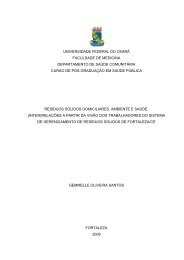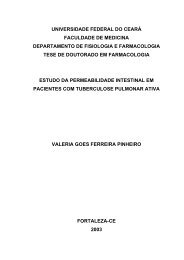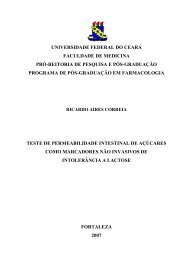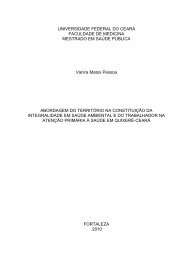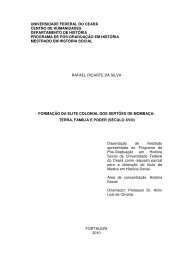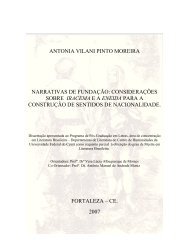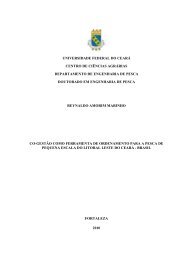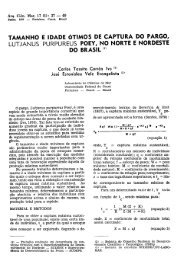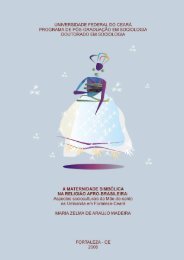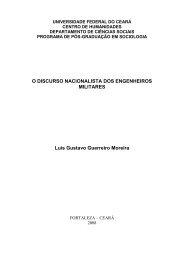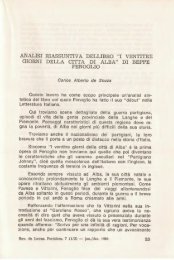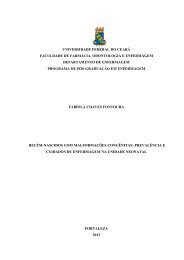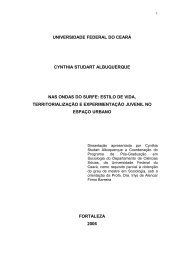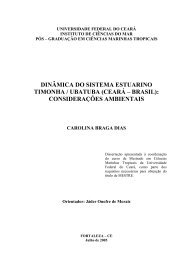Tungíase: doença negligenciada causando patologia grave
Tungíase: doença negligenciada causando patologia grave
Tungíase: doença negligenciada causando patologia grave
You also want an ePaper? Increase the reach of your titles
YUMPU automatically turns print PDFs into web optimized ePapers that Google loves.
Tropical Medicine and International Health doi:10.1111/j.1365-3156.2010.02545.x<br />
volume 15 no 7 pp 856–864 july 2010<br />
A simple method for rapid community assessment of tungiasis<br />
L. Ariza 1 , T. Wilcke 2 , A. Jackson 2 , M. Gomide 3 , U. S. Ugbomoiko 4 , H. Feldmeier 2 and J. Heukelbach 5,6<br />
1 Post-Graduation Program in Medical Sciences, School of Medicine, Federal University of Ceará, Fortaleza, Brazil<br />
2 Charité University of Medicine, Institute of Microbiology and Hygiene, Berlin, Germany<br />
3 Institute of Collective Health, Federal University of Rio de Janeiro, Rio de Janeiro, Brazil<br />
4 Department of Zoology, University of Ilorin, Ilorin, Nigeria<br />
5 Department of Community Health, School of Medicine, Federal University of Ceará, Fortaleza, Brazil<br />
6 Anton Breinl Centre for Public Health and Tropical Medicine, James Cook University, Townsville, Qld, Australia<br />
Summary objective To evaluate a rapid assessment method to estimate the overall prevalence of tungiasis and<br />
severity of disease in endemic communities.<br />
methods We analysed data from 10 population-based surveys on tungiasis, performed in five endemic<br />
communities in Brazil and Nigeria between 2001 and 2008. To assess the association between occurrence<br />
of tungiasis on six defined topographic areas of the feet and the true prevalence ⁄ prevalence of<br />
severe disease, linear regression analyses were performed. Estimated prevalences were calculated for<br />
each of the 10 surveys and compared to true prevalences. We then selected the most useful topographic<br />
localization to define a rapid assessment method, based on the strength of association and operational<br />
aspects.<br />
results In total, 7121 individuals of the five communities were examined. Prevalence of tungiasis<br />
varied between 21.1% and 54.4%. The presence of periungual lesions on the toes was identified as the<br />
most useful rapid assessment to estimate the prevalence of tungiasis (absolute errors: )4% to +3.6%;<br />
R 2 = 96%; P < 0.0001). Prevalence of severe tungiasis (>20 lesions) was also estimated by the method<br />
(absolute errors: )3.1% to +2.5%; R 2 = 76%; P = 0.001).<br />
conclusion Prevalence of tungiasis and prevalence of severe disease can be reliably estimated in<br />
communities with distinct cultural and geographical characteristics, by applying a simple and rapid<br />
epidemiological method. This approach will help to detect high-risk communities and to monitor control<br />
measures aimed at the reduction of tungiasis.<br />
Introduction<br />
keywords tungiasis, Tunga penetrans, Rapid Assessment Method, Brazil, Africa<br />
Tungiasis is a tropical parasitic skin disease caused by<br />
penetration of the jigger flea Tunga penetrans (Linnaeus<br />
1758) into the skin of human or animal hosts (Heukelbach<br />
2005). Hundreds of parasites may accumulate in heavily<br />
infested individuals (Feldmeier et al. 2003; Joseph et al.<br />
2006; Ugbomoiko et al. 2007). The disease is a self-limited<br />
infestation (Eisele et al. 2003; Feldmeier & Heukelbach<br />
2009), but complications such as bacterial super-infection<br />
and debilitating sequels are often seen in endemic areas<br />
(Bezerra 1994; Heukelbach et al. 2001; Feldmeier et al.<br />
2002, 2003; Joseph et al. 2006; Ariza et al. 2007;<br />
Ugbomoiko et al. 2008). Septicaemia and tetanus are<br />
life-threatening complications of tungiasis (Tonge 1989;<br />
Litvoc et al. 1991; Greco et al. 2001; Feldmeier et al. 2002;<br />
Joseph et al. 2006).<br />
Typically, the disease occurs in poor communities in<br />
Latin America, the Caribbean and sub–Saharan Africa<br />
(Heukelbach et al. 2001; Heukelbach 2005). In recent<br />
cross-sectional studies from endemic areas in Brazil,<br />
Cameroon, Madagascar, Nigeria and Trinidad & Tobago,<br />
point prevalences ranged between 16% and 54% (Chadee<br />
1998; Njeumi et al. 2002; Wilcke et al. 2002; Carvalho<br />
et al. 2003; Muehlen et al. 2003; Joseph et al. 2006;<br />
Ugbomoiko et al. 2007; Ratovonjato et al. 2008). However,<br />
prevalence and distribution of the disease are not<br />
documented in most endemic areas.<br />
In settings where financial and human resources are<br />
scarce, policy makers need cost-effective and simple<br />
methods to estimate prevalence and severity of disease in<br />
affected populations (Anker 1991; Vlassoff & Tanner<br />
1992; Macintyre 1999; Macintyre et al. 1999). As a<br />
consequence, rapid assessment methods have been<br />
856 ª 2010 Blackwell Publishing Ltd



